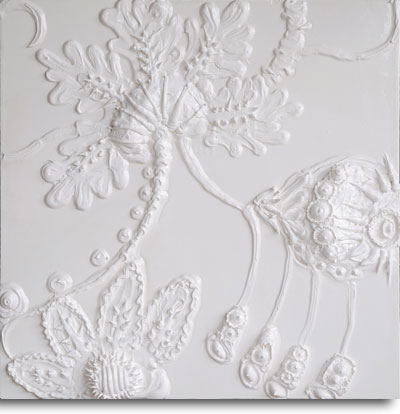Aug 2008

PORTLAND / EUGENE
Eugenia Pardue at B Rogers Gallery and the
Jordan Schnitzer Museum of Art
Known in the Northwest and the Bay Area
for her brashly colorful semi-abstract paintings, Eugenia Pardue debuts a
surprisingly monochromatic body of work in two overlapping shows: a solo show at
the B Rogers Gallery in Portland and the lively survey “New Art Northwest” at
the Jordan Schnitzer Museum of Art, at University of Oregon, Eugene. While much
subtler in palette than her erstwhile bubblegum-hued extravaganzas, the new
works retain the freewheeling sculptural quality of the previous work. Formally,
the works in both shows consist of a flat white plane, with vernal motifs rising
in relief, as much as four inches above the base. These motifs riff on rococo
and Victorian illustrations, scrolls, flowers, grape clusters, weeds, and vines.
At times the application of acrylic paint is gloppy (as in the museum’s Tree of
Life), at times clean (as in the gallery’s Dawn). The works are at their most
effective when the execution is immaculate and the composition dynamic, as in
the gallery’s Bequeath and Twilight, the latter of which makes sophisticated use
of negative space. The museum show highlights works with redolent natural
references, like the jaunty flecks suggesting pollen in the resplendent Bouquet,
or that exude the mien of danger, á la the carnivorous, Venus-flytrap-like
spikes in Kashmir.
Pardue is a gifted visual thinker whose work both
critiques and indulges in the arbitrary distinctions contemporary artists and
critics draw not only between painting and sculpture but also between Abstract
Expressionism, Minimalism, and the decorative. Texturally maximalist,
chromatically minimalist, the artist’s new works aim to push the physical
properties of acrylic paint to their limits via unlikely manipulations such as
braiding, stabbing, cutting, razor-blading, hack sawing, squeezing, pinching,
and nailing with equipment ranging from dental tools to cake decorating nozzles.
It is ironic that Pardue, who seems to rebel against the mechanistic nature of
our age, is at her most effective when her works forego the gloopy, gloppy
mounds that so often populate them and instead showcase a facility for pristine
lines and fresh, airy compositions, carried out with almost machine-like
precision, as in the delightful four-panel Pachelbel at B Rogers. Pardue’s most
inspired flights are paeons to the luxuriance of nature. Yet because art can
never truly replicate nature’s chaos, it serves the artist best to merely
suggest nature—a high order, best accomplished not through unchecked fecundity
but through specificity and precision.
